|

Home

FAQ

The Book

Articles

Links

Contact

|
|
The Influence and Imagery of Akira
Kurosawa
part II: Star Wars
Now that we have examined the overall picture and scope of
Kurosawa's influence and its relation to Lucas' technique, we should look
at specific examples within the Star Wars films that derive imagery
from Kurosawa. Because although it is true that Lucas' films,
specifically the Star Wars ones, do not share very many
fundamental techniques, there is still an explicit and continual influence of
Kurosawa. Once Lucas returned for the prequels, he brought with
him an even greater plethora of references to the Japanese master, perhaps as
a result of watching, studying and absorbing his work during Lucas'
twenty-year retirement. For starters, Lucas almost exclusively used
the two-camera set-up, just as Kurosawa did in his later, seminal
period. Phantom Menace is also
unique in that it also contains many other techniques of
Kurosawa's, for it is perhaps the most overtly Kurosawa-influenced film
of Lucas' filmography--fitting since it also based its plot on
Hidden Fortress, and follows it much
more closely than Star Wars. Aside
from the hugely significant lack of telephoto photography, Phantom Menace is
otherwise visually composed so similarly to any of
Kurosawa's later pictures, circa Ran
, that it almost feels as if Kurosawa himself might have arrived at
a film of similar compositional integrity--emphasis is placed on the master shot, the
action is driven by editing and movement through the frame rather
than crane shots or dollying as most modern films do, and there
is a sense of stillness of staticness to the movie, with an emphasis
on composition. There is a synthesis of many of the qualities of
Kurosawa's later work, although told without the stylized telephoto
photography and instead through more traditional normal and
wide-angle coverage--in fact, there is a jarring lack of telephoto
shots in the prequel trilogy overall, except in close-up use which
of course is where telephoto coverage is traditionally used (since the shallow
depth of field isolates characters for the
audience).
Perhaps it was because Lucas was away from the
camera for so long that he had yet to develop--or re-develop--his
own style, instead emulating that which he had studied and admired
for so many years. With Attack of the
Clones, this emulation would be left behind--compositional
emphasis and a feeling of staticness was replaced with camera
movement and more dynamic and modern technique, which many upheld as
a sign that Lucas was stretching his directorial wings. Indeed, Attack of the Clones and Revenge of the Sith exhibit stylistic
devices that one imagines Lucas would never have used in Phantom Menace, from the hand-held combat
camerawork of Attack of the Clones to
the dynamic and in-your-face digital cinematography displayed
through the opening action sequence of Revenge of the Sith (a good example being
the opening, Lord-of-the-Rings-inspired fly-by, or the shot of the
separatist cruiser crash-landing which sees the craft rocketing from
a distance and finally settling just a few feet from the lens). The
deliberately rigid formality in performance of Phantom Meance also became replaced by
more expressive emoting. However, although Lucas left behind the
more overt Kurosawa references in Phantom
Menace , many specific visuals still were derived from him. As
a final piece of closure we shall now look at some of
those.
Star Wars was first
written as a remake of Hidden Fortress--by the time Lucas
got to the final draft the film had deviated quite considerably and
emerged as its own unique creation; however, a number of explicit
links still remained, and in some cases Lucas emulated specific
shots. This extends to some instances in the sequels as
well.
 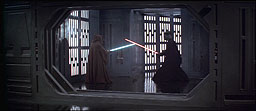
 
 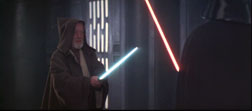
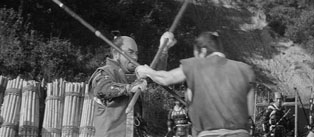 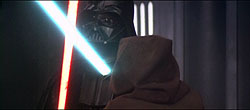
The original Darth Vader,
General Hyoe Tadokoro:
 
The original
droids:
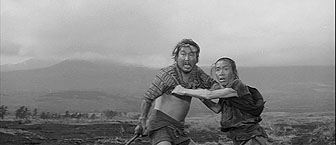
Both
films have a similar ending
ceremony:
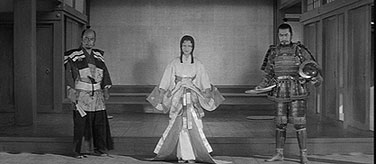 
The cantina brawl is of
course sourced from Yojimbo:
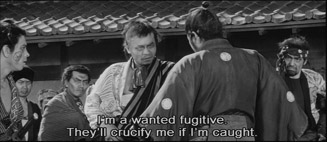 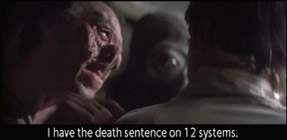
 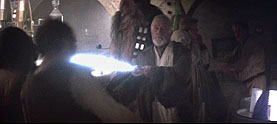
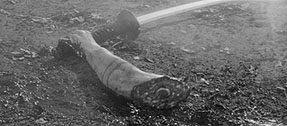 
This trick of hiding under
the floor comes from
Sanjuro:
 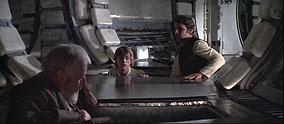
CONTINUE TO PART
III
Star
Wars, the Star Wars logo, all names and pictures
of Star Wars characters,
vehicles and any other Star Wars related items are registered
trademarks and/or copyrights of Lucasfilm Ltd., or their respective
trademark and copyright holders. All other images are copyrights of
Toho studios. They are used here for educational purposes under fair
use.
Web site and all contents
© Copyright Michael Kaminski 2007, All rights
reserved.
Free website templates
|
|